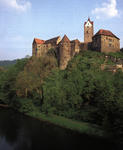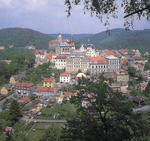 Loket, tel.: 0168 - 94104
Loket, tel.: 0168 - 94104
A royal watch castle with Romanesque foundations from the 12th century, rebuilt by the Slik family in the 16th century. At the beginning of the 19th century, the castle was transformed into a jail, which was in operation until 1949.
On the ground floor of the wing close to the tower and the Captain's house there is an exhibition devoted to the castle's history, on the 1st floor an exhibition of porcelain.
Sight-seeing tours can be booked with the castle's administration.
A Romanesqe rotunda, tower and four floors of prison cells in the Lower bastion.
Once a royal castle, Loket was known as long ago as in 1234 and it is well possible that it was built even earlier, in the 11th century. Its name Loket, meaning elbow in English, is probably derived from its unique location on the top of a cliff in an elbow of the Ohre river. It is one of the oldest Czech castles preserved to our times which has not been turned to ruins and the clearest demonstration of the Upper Falz style of castle building, which is characterised by the massive rectangular tower. Soon after its founding it became the administrative center of the region and a mighty stronghold, taking over the position of the ancient castle of Sedlec. In 1308, the nearby Town of Locket started to develop under the protective castle walls. In the 14th century, the warrior king John of Luxembourg hold in this castle his son Wenceslas  (who was later to become the Emperor Charles IV.) a prisoner as his father was extremely jealous of his throne. At the end of 14th century, the early-Gothic castle underwent an extensive reconstruction. Parts of walls and battlements and the great tower remained untouched by the reconstruction and can be still seen today as they looked 800 years ago. The Hussites were attempting to storm the castle several times during the Wars of religion in the 15th century, but the castle always hold out, due partly to its natural defence conditions, partly to the heroic fight of the defenders. pre. From 1434 it belonged to the powerful house of Slik of Jachymov. In the beginning of the 17th century it was bought by the nearby City of Loket.
(who was later to become the Emperor Charles IV.) a prisoner as his father was extremely jealous of his throne. At the end of 14th century, the early-Gothic castle underwent an extensive reconstruction. Parts of walls and battlements and the great tower remained untouched by the reconstruction and can be still seen today as they looked 800 years ago. The Hussites were attempting to storm the castle several times during the Wars of religion in the 15th century, but the castle always hold out, due partly to its natural defence conditions, partly to the heroic fight of the defenders. pre. From 1434 it belonged to the powerful house of Slik of Jachymov. In the beginning of the 17th century it was bought by the nearby City of Loket.
The castle was desolated in the 30-years war which lasted from 1620 to 1648. Most of the importance of the castle was lost after the deterrioration of the feudal system in the beginning of the 18th century. The great fire in 1795 almost destroyed the castle and it had to be rebuilt before the State began to use it as a prison in 1822. The much damaged castle was reconstructed after 1945 and now it is open for public. The castle houses an exposition of the Bohemian china. The region of Locket was the centre of china production since 1792, when the china works at Horni Slavkov started production. There were also china works in the very town of Locket, founded by brethren Haidinger in 1815. The collection includes several priceless Baroque and Classicist china jugs and services. The museum also cherishes memories of the German poet J.W. Goethe, who was an admirer of the Western Bohemia region, and the largest meteorite which ever landed in the country (109 kg) A legend says that it is the evil master of the castle turned to stone for his sins.



 Guide
Guide 





